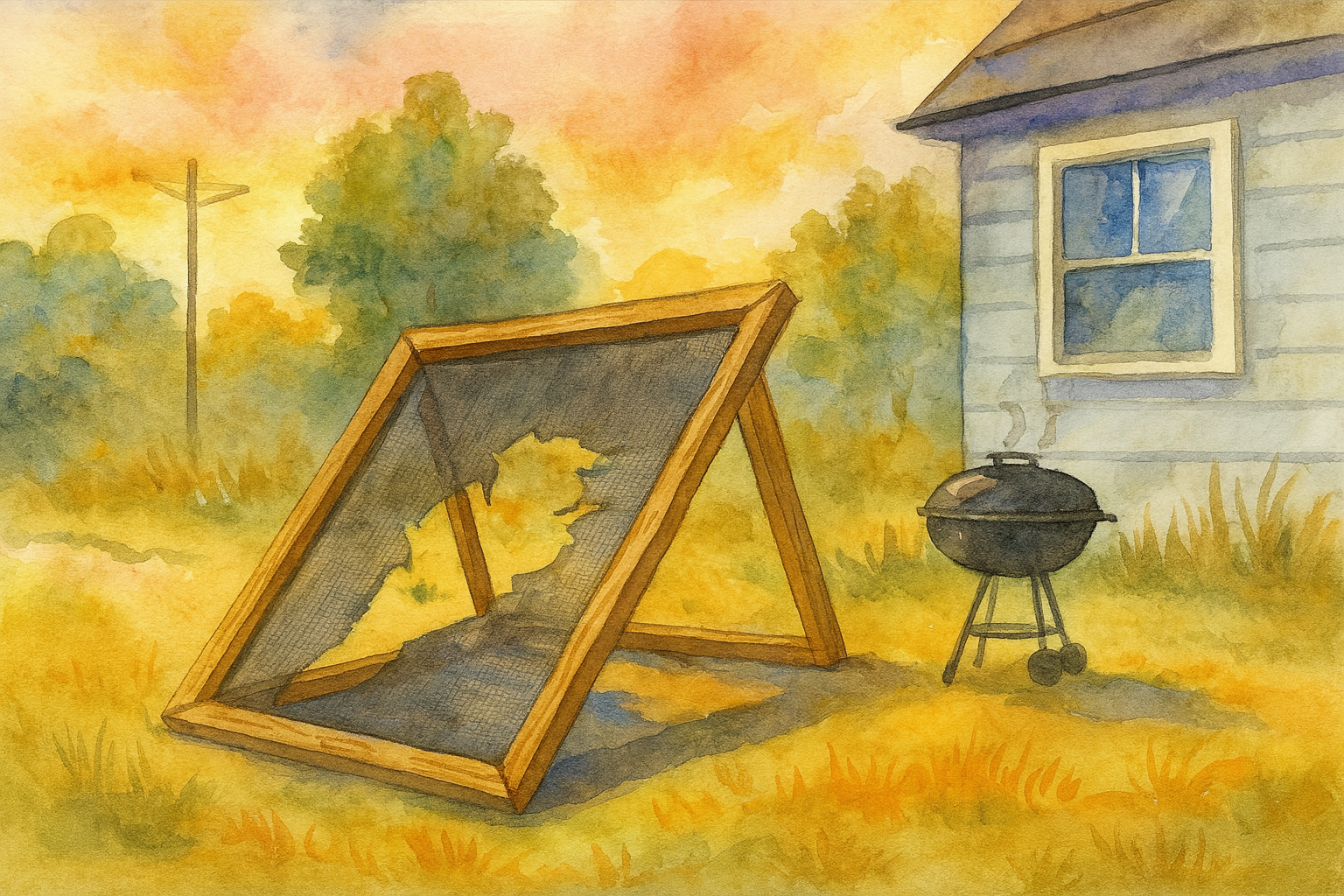

Image: Two common window screens leaning against a wall. These typical builder-grade screens have flimsy fiberglass mesh and lightweight frames – fine for bugs, not for burglary. Ever get that new-car feeling – until the credit card bill arrives? That’s how builder-grade window screens feel. Home builders often install ultra-cheap fiberglass mesh “screens” that cost them almost nothing, and you’ll discover they provide almost nothing. A guy I met said, builders toss in fibreglass mesh “so thin it barely keeps out mosquitoes” . The frames are usually soft aluminum that bends with the gentlest breeze. Within a season, you’re looking at sagging mesh, popped-out frames, and mystery holes inviting every bug in the neighborhood . In short, standard screens give you zero real security, minimal bug protection, and no durability . They’re the “McMeal” of home construction – cheap and filling nobody up.
DIY “upgrades” like stronger rollers or fresh paint can’t fix the fundamental weakness: builder mesh is built for bugs, not burglars. You might think “Hey, they’re free with the house!”, but you’ll pay dearly in repair trips, and heartburn every time you look at those sagging screens.
Real Security Screens: Home Armor, Not Home Decor
Imagine: Close-up of a premium security screen. Notice the tightly woven stainless-steel mesh and sturdy framing – this is the kind of screen that stops crooks, not just bugs. Now picture the opposite: screens built like armor, not sandwiches. Real security screens use high-tensile stainless steel mesh (often marine-grade 316 or 304) woven into a fine grid, all held in a heavy-duty aluminum frame . This mesh isn’t meant to rip or sag – it’s designed to resist cutting, slashing, and impact . In lab tests, these screens held up to 800+ pounds of force, while cheap aluminum mesh failed under ~100 lbs . In practice that means no scissors, utility knives or crowbars will cut through it – aluminum “security” mesh would just fray the instant you try . In short, a genuine security screen is a crowbar-stopper, not just a bug-blocker. (As one installer jokes, cameras are great – but “they don’t stop a crowbar” .)
These screens still function like normal screens – they let air in, keep bugs out, and don’t look like prison bars. In fact, the stainless mesh is coated black for good sight-lines, so from inside you barely notice anything except fresh air. The walls may be solid, but the view stays clear.
In practice, that means a security screen won’t pop out like a cheap screen door, won’t let itself be kicked in, and can’t be sliced with a knife. It’s working 24/7 even when you’re asleep or away: passive, power-free protection . And yes, it costs more up front – but as the experts note, this investment is worth it . You’re not just paying for mesh; you’re buying real peace of mind.
Imagine two homeowners. Homeowner A uses standard builder mesh (about $15–$30 a screen) and never thinks of security until the window’s been smashed. Homeowner B spends a thousand per window on stainless security screens. Years later, A has replaced dozens of torn screens and had one break-in, while B’s still enjoying the original protection – no bug, no break-in. The math adds up.
The bottom line: security screens aren’t a frill – they’re a smart long-term investment. Even if your budget is tight, consider it this way: one quality screen (or door) might cost as much as dozens of buggy Home Depot replacements over its life. Plus you’d be avoiding the headache of repeat repairs.
A small business owner, wasn’t satisfied with cameras alone. She invested in security screens for her storefront windows. She told us afterwards, “I sleep so much better knowing even if a storm or an idiot strikes, those screens won’t budge.” In fact, many customers say the first thing they notice is peace and quiet. Security screens mute the outside world – wind, noise, even burglary attempts – while still letting a breeze and sunlight in.
Whether it’s a detached home, a cottage rental, or a ground-floor office, our clients tell a common story: Once you upgrade, you realize how unsafe cheap screens truly were. And in Ontario weather, year-round performance matters. Stainless screens resist rust and stand up to snow, ice and salt – they’re not just a summer toy . When spring floods or winter storms arrive, these screens simply shrug and keep your windows secure. (Think of them as cousins of our insulated security shutters – another year-round protection – but with open-air comfort .)
Remember, security screens do more than block criminals. They block pests too – from houseflies to wasps. The tight weave keeps out even tiny insects, so you get fresh air without the itch . And for pet owners, we have an extra-strong option: pet-resistant vinyl mesh, about 7× tougher than fiberglass . It costs a bit more ($40–$70 extra per screen), but it saves on shredded screens and saves your kitty’s pride. (See our Pet-Resistant Mesh page for details – it’s the same beefy polyester-coated mesh that we recommend for active homes .)
Better airflow and clarity are built in too. Unlike ugly security bars, these screens look modern and let you see out clearly. They’re dark-coloured so they hide in shadows and don’t glare in sunlight. Most customers are amazed: “It’s still mywindow – just way safer,” is a common refrain.
Let’s spell it out. A builder-grade screen might save $80 today, but it could cost $200+ over a few years in repairs and hassles. A premium security screen might be $750 now, but if it saves one break-in or lasts 10 times as long, it pays for itself. If a single burglary would set you back thousands, that math gets very compelling. And don’t forget intangible returns: tranquility, privacy (some meshes have a slight “one-way view” effect at night), and even energy savings. For example, tightly woven meshes can block a chunk of solar heat in summer, cutting AC bills.
Contractors and home-security pros all say the same thing: cheap screens are false economy. Marine-grade stainless “lasts over 20 years” and “cannot be easily cut or kicked in” . Aluminum or fiberglass screens cannot claim that. If your goal is real protection and a good return on investment, the upfront price of security screens makes sense – especially when compared to the ongoing cost of failures.
Security is a 24/7 job – not just something you need in summer. Stainless screens stand up to Ontario winters just as well as summers . They won’t rust or fatigue in freezing temperatures, and they keep snow and debris off your window. In fact, many clients pair security screens with our insulated shutters for the ultimate all-weather defense. But even without shutters, a security mesh is like sunglasses and a storm shield for your window: it cuts glare, wind and cold while keeping out intruders .
In off-season cottages or rentals, that means you can leave windows open a crack (for ventilation) without panic. On blizzard nights at home, it means one more barrier between you and the storm (and prowlers).
Cheap, builder-grade screens might lure you in with a zero price tag, but they won’t save you money – or your home. Real security screens do cost more, but they also do more. They keep families and businesses safer, they last decades, and they add genuine value to your property . As one specialist put it bluntly: either buy once and cry once (for the up-front), or buy cheap and cry (and buy again) forever.
At WindowRises, we handle it all. If your current screens look like they’ve seen better days, we can repair or replace them. We’ll even upgrade them with the right mesh – from pet-proof to high-tensile security – at clear, honest pricing . Whether it’s a home, a storefront, or a snowbird cottage, our screens let in the breeze and keep out the trouble.

